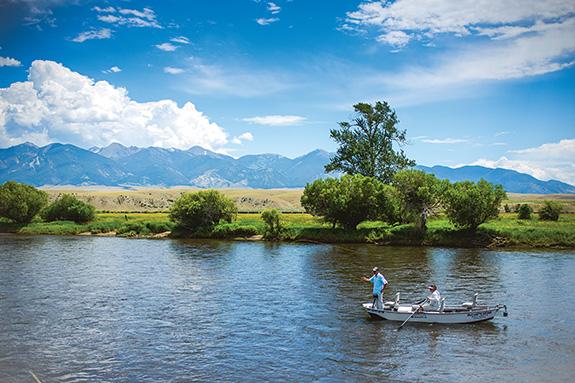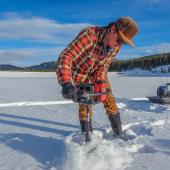Jefferson Rising
A restoration success story.
Forgotten. Ignored. Overlooked. Spurned. Maybe even scorned.
The Jefferson River has never had much of a reputation among fishermen. The “Jeff” is the river you drive along as you are headed to its famous headwater streams: the Ruby, the Beaverhead, and the Big Hole. The Jefferson? Not so much.
From its genesis at the town of Twin Bridges downstream 80-plus miles to where it meets the Gallatin and the Madison to form the Missouri, the Jefferson River flows through some of the prettiest ranch country in the entire state of Montana. But to the eye of an angler, it often doesn’t look like much.
Two decades ago, a mentor and life-long fishing friend of mine bought a beautiful little farm not far from the banks of the Jefferson near the little town of Silver Star. He was elated and so was I, because I had friend with a spare bed next to a Montana river, a river named and navigated by Lewis and Clark, a river of trout.
But then I remember my first trip out for a visit. As I rattled my pickup across a beautiful historic old bridge at the Silver Star fishing access, I was shocked at what flowed beneath. What was called a “river” barely passed for a good-sized creek. It was “froggy” and full of algae and, frankly, looked like hell. We fished it a few times in those years, but it was often closed to fishing as late-summer temperatures turned the water more habitable for carp than trout. When we did fish, we rarely boated a thing. Our fishing trips turned into sight-seeing floats as we watched sandhill cranes dance in nearby alfalfa and velvet-antlered whitetail bucks splash across the river. The Jefferson, we conceded, had other merits. We went to other rivers for the fishing.

That was the 1990s. Had we been there a decade earlier, we might have had another view of the Jeff. In the 1980s, it was better known, more often fished, and, most importantly, had more water. Yet, it was still called forgotten. A 1984 Outdoor Life article called it “the river that fishermen forgot,” and then went on to recount a 70-fish day between three anglers, which is a pretty darned good day on any Montana river. The same article also mentioned fish in the eight-to-eleven-pound range.
But then came drought. First in 1988, the same year Yellowstone burned to the ground, when the Jefferson dried nearly to sun-bleached cobble riverbed. Then came the parched mid-1990s. After that pounding, the fishery in the Jefferson gave fishermen a good reason to forget about the river. High water temperatures and more water going onto hay fields than down the river channel drove trout numbers right off the cliff. It also drove anglers to the cold tailwaters of the Beaverhead and the high mountains of the Big Hole. Meanwhile, the Jefferson sweltered.
But the Jefferson had a hole card—a man named Bruce Rehwinkel, a fisheries biologist who really cared about the river. In the ’80s, when he worked for Montana Fish, Wildlife & Parks, he took to solving some of the problems on the Jefferson with a good sharp spade. It’s important to remember that during Rehwinkel’s career as a state biologist, the Jeff was just one of many trout rivers, streams, and lakes that fell under his purview. But the Jefferson clearly needed the most love. What the Jefferson needed, Rehwinkel and others felt, was more water in the river, and more spawning habitat in the tributaries. In a now-legendary shovel incident, Rehwinkel narrowed and deepened a channel with the hand tool on a private spring creek that fed much-needed cold water into the Jefferson near the farm settlement of Waterloo. He dug a new channel by hand, by himself. It was enough. Almost immediately, rainbow trout began swimming up into the creek to spawn, which eventually returned more fish to the river.
But in the world of modern-day fisheries management, just caring often isn’t enough. Throughout Rehwinkel’s career, first as a fisheries biologist for the state and then as an employee of Trout Unlimited, he has been known as a hard-charger, a driver personality with a knack for building lasting, trusting relationships. Rehwinkel had no quit in him.
“His mantra has always been ‘If you see the ball, pick up the ball and run with the damned ball,’” says Pat Byorth, who runs Trout Unlimited’s water policy in Montana after a career as a fisheries biologist for Montana FWP. “He pretty much shaped my career and showed me how to get things done.”
In the 1990s, Rehwinkel saw the river that had been glorified in Outdoor Life—an article in which he was quoted—go down the tubes. Together with another like-minded state biologist, Ron Spoon, he started talking to water users, trying to figure out a way to help the river and at the same time get enough water for the hay crop. Up on Hell’s Canyon Creek, a dashing little tributary that drains out of the granite grip of Highland Mountains north of Twin Bridges, Spoon found a ranching couple who loved the creek, but didn’t like to see young rainbow trout dying in their hay meadows. Alan and Dolly Carroll worked with the state and groups that included Trout Unlimited to retool their irrigation system from old-school flood irrigation to efficient sprinklers, leaving the Carrolls with more than enough water for their hay crops. A fish screen was installed on the system to prevent stranded trout. And the leftover water that was now not needed to water grass, ended up back in the creek through a lease with the state. Rainbow trout returned to Hell’s Canyon Creek to spawn like never before.
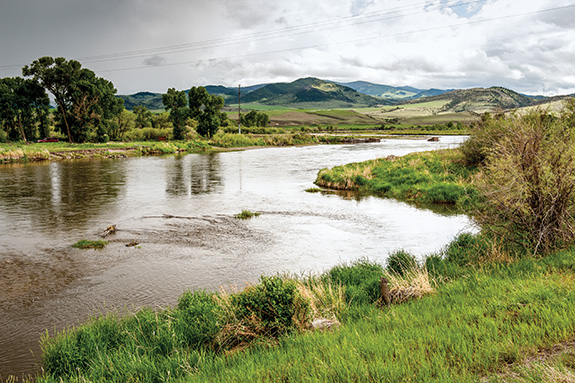
No one person can do it all in a big river valley like the Jefferson. Drought, while sometimes a catalyst for huge battles, can also bring people together. At the tail end of those dry ’90s, a group of water users called the Jefferson River Watershed Committee saw what had been happening to the Jefferson. They decided to work closely with Spoon, who had now taken Rehwinkel’s place as the FWP biologist on the Jefferson after Rehwinkel retired. By this time, Spoon was as widely respected and trusted as his predecessor. So he and the group worked up a drought-management plan, a way to keep some water in the river for the fish, while at the same time finding water for their crops so they could earn a living. Ranchers like committee chairman Gary Nelson, as well as Bob Lombardi, Dean Hunt, John Kountz, Joe Schlemmer, and Mark Franich found a way to get the job done on the Jefferson and help the fishery rebound. Meanwhile, fishermen had to do their part. When the water warmed to 73 degrees for three consecutive days, the state enacted emergency regulations that shut fishing down from two in the afternoon until midnight; a.k.a, hoot owl.
August is a tough time for trout in the West when many demands are put on water. This has been especially true of the Jefferson, where a gauge at Waterloo went below 20 cubic feet per second during an infamous stretch in August one year. This is on a river that has a mean annual flow of more than 2,000 cfs. No one on the committee ever wanted to see the gauge that low again. So they came up with triggers that called for voluntary return to the river. Since the drought plan was enacted in 1999, a serious drought event at Waterloo has been avoided.
Meanwhile Rehwinkel couldn’t keep still. Retired now, he still thought about the Jefferson. And so, when Bruce Farling, executive director of Montana Trout Unlimited, came to him with an idea, he jumped on it. Why not make Rehwinkel, a man whose job had been overseeing fisheries management on the Jefferson and many other southwestern Montana waters, a full-time employee of TU? His only job? Fix the Jeff.
Using seed money from Orvis and other donations and backed by the leadership at TU in D.C., Farling was on to something and he had the right man for the job. Rehwinkel, now an employee of TU, dusted off his waders and “picked up the damned ball.” And his one-time protégé, Spoon, was now his full partner in the work.
First up was Willow Springs Creek, near Waterloo. Then Parsons Slough, also nearby. Channels that had been widened by decades of livestock use were narrowed again and fenced. Landowners pitched in. Spawning gravels were opened. Trout, especially rainbows, returned. Spawning bed (redd) counts soared. On Willow Springs Creek in 1991, only 46 redds were counted. In a few years, that number had doubled. By 2007, that number had doubled again to 201. Not as many redds existed to begin with in Parsons Slough, but it too saw the numbers increase. Moreover, the eggs were hatching and young fish were surviving. They lived in Parsons for a year until they were three inches long, then swam into the Jefferson in remarkable numbers. Another small tributary, Sappington Spring, was developed and brown trout prospected up into the new spawning ground almost as soon as construction was completed in 2005. Rehwinkel and Spoon kept going.
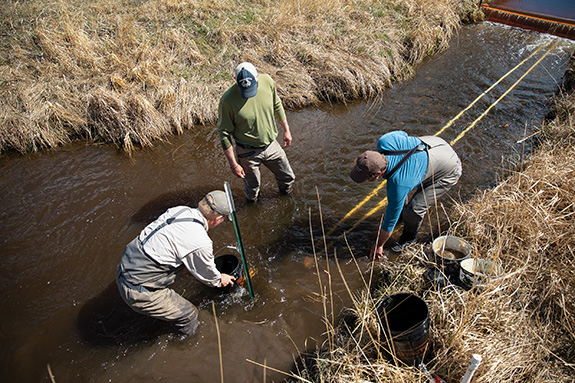
Around the same time, fishermen were starting to notice. One August morning, I drove my pickup across the river to my friend’s house. The old classic bridge was now gone, having been removed and transported to Missoula where it was refurbished and used on a bike path across the Clark Fork. In its place was a new concrete structure.
Something else was different too. There was water in the river, not the thin pea soup of the past, and in the Silver Star fishing access right off Hwy. 287, there were a dozen vehicles with empty boat trailers. A decade earlier, one would have been hard-pressed to see a single bank fisherman soaking worms. The fishing had gotten better and word was out.
We started to pick up fish on our own trips. More and more fish. A favorite stretch from the town rest stop in Twin down to the Iron Rod bridge drew in even more fish. We now were considering the shorter drive to the Jefferson, our own home river, rather than a longer trek to its more famous headwater rivers. The Jeff was on the rise.
One day I netted a half dozen browns in a couple of hours. On another day, I took a huge hen rainbow from a riffle run I had discovered and learned how to fish. I also learned that, unlike other rivers with lots more fish, the fish in the Jeff were where I found them. In other words, they hung in the same places and that was where they stayed. Other places seemed completely devoid of fish. Find them, though, and it was on. In riffle-pool complexes, where I could swing a big streamer then slowly twitch back through the pool, I fished the corners and caught fish. I fished under beautiful fallen cottonwood trees, places that just screamed “big brown!” and caught nothing. I went back another time and caught fish at the corners and none at the cottonwood lairs. I was learning.
My experience on the Jefferson is similar to that of others. Most visiting anglers will hire a guide who knows the river and that’s a good move. Going blind on the Jeff will frustrate and irritate. Zack Cockrum, a friend from the D.C. area, came to Montana a few years ago with his dad. On a five-day trip, they hit a bunch of water and had great fishing. But it was his tale of the Jefferson that was most memorable. It was mid-August and they put on the river early and floated down through some promising riffle-pool series.
“We’d swing these big streamers out over the drop and strip, then, wham!” remembers Cockrum. They caught several nice rainbows in the 17- to 19-inch range that day.
One evening they were lucky enough to hit the Ephoron (white mayfly) hatch and had great action on dries in the fading light of a long Big Sky day. “That was really what stood out, that we could get fish on streamers and on dries, but you had to know where to go and how to do it,” says Cockrum.
Electro-surveys by state biologists confirm what fishermen have learned. The Jeff’s trout like particular habitats and not all habitats. And the trout are back. “We’ve come a long way,” says Montana TU’s Farling. “We’ve got 1,200 fish per mile, big browns, big rainbows. I think this has been one of the best-producing restoration projects in the country.”
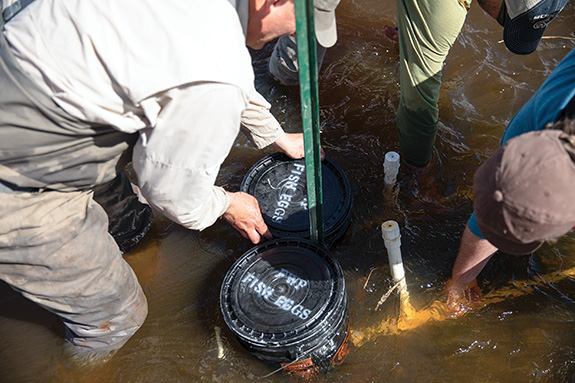
From the outset, Rehwinkel’s goal was to boost the fish-per-mile from a low of 288 per mile to 1,000 fish per mile. In 2014, that target was surpassed when 1,244 trout were surveyed per mile. While Spoon thinks that number may go down a bit, there is no overlooking a success.
Yet before anglers start scampering off to the Jefferson in search of trout heaven, it’s best to remember that the Big Hole averages over 2,000 trout per mile and the Beaverhead is stuffed almost twice that number, some 3,800. But all of this doesn’t mean that the Jefferson can’t improve, nor that the picture is all rosy either. “We have a shortage of spawning habitat, particularly in the lower part of the river,” Spoon says. Recent counts on the lower river show a mere 200 trout per mile.
While there are some ways to possibly improve spawning habitat or put more fish in the river, Spoon doesn’t think a return to the old days of the 1980s is likely. In those years, even low down in the river not far from Three Forks, state biologists—Rehwinkel and company—surveyed 600 fish per mile. Those were also extremely good water years, from the 1970s into the early 1980s, only to be swashed by the epic drought of 1988. The lower portion of the river suffers from a lack of tributaries and a lack of cold water. “We just aren’t getting very good recruitment,” says Spoon.
But there is some promise. A cold spring on private land in the Boulder River valley—the most significant water source in the lower river before it heads into Jefferson River Canyon—could be a place where fishermen and ranchers again come together for the river and its trout. Willow Creek, near the town of the same name, could be a place for collaboration between water users and anglers.
One thing is clear, according to Spoon: the trust and value of relationships needs to be built and maintained. Change is everywhere and constant. The Jefferson River Watershed Committee has gone through some significant alterations. Montana have been in a wild state of change, from dry and hot to wet and cold in recent years. Challenges.
For Rehwinkel, who is now in his second retirement after several years leading the charge for TU, challenges are just opportunities in waiting. “I think that it’s all upward, there’s lots of things we could be doing to help that river,” he says. “Can you imagine being paid to work on one river, and it’s a full-time job? Hell, a trained monkey could do that.”


